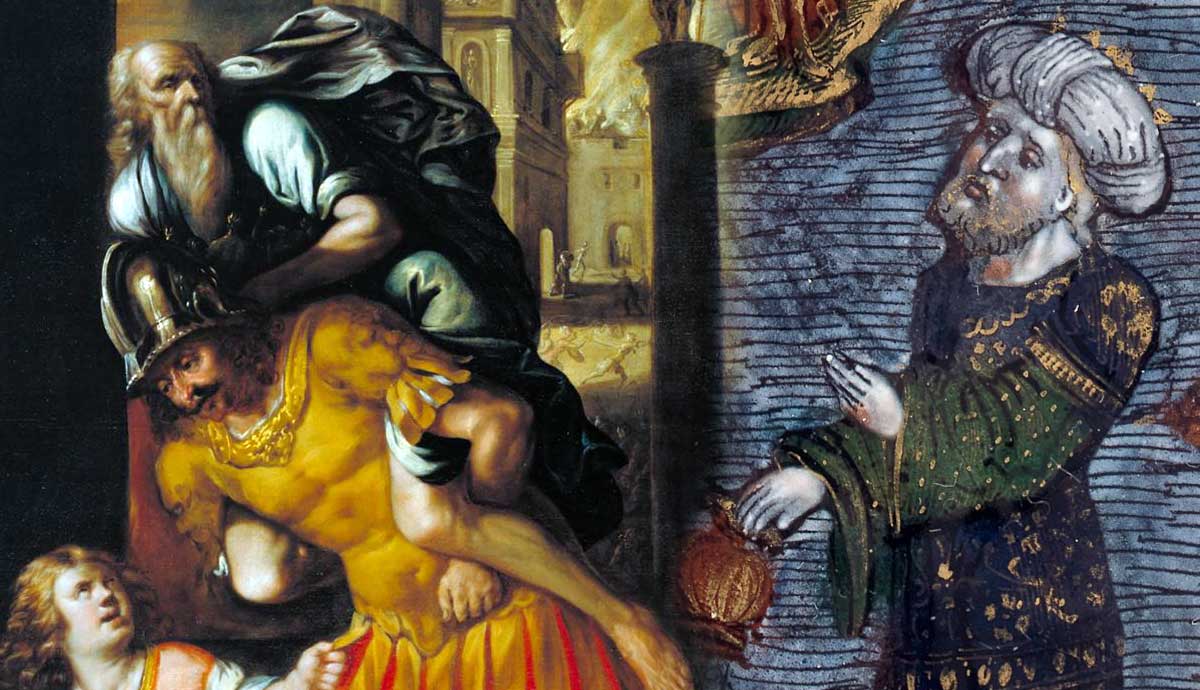
Aeneas of Troy is a figure from ancient Greek mythology. However, he found fame for his involvement in the foundation of Rome thanks to an epic written about him by the Roman poet Virgil in the 1st century BCE. There are many misconceptions about what the sources say about Aeneas, particularly about what belongs to the Greek tradition and what seems to have been invented by Virgil for his Roman epic. This article will examine what surviving sources reveal about the life of Aeneas of Troy.
Aeneas in Homer’s Iliad

Aeneas appears in the Iliad, written by Homer in the middle of the 7th century BCE. He is a prince of Troy, although far from being directly in line to the throne. He was the son of Anchises, son of Capys, son of Assaracus, son of Tros, founder of the kingdom of Troy. To put this into perspective, the reigning king of Troy at the time of the Trojan War in the Iliad was Priam, son of Laomedon, son of Ilus, son of Tros. Therefore, we can see that Aeneas was only distantly related to the reigning king of Troy, being his second cousin once removed.
Understandably, Aeneas is not one of the main characters in the Iliad. In fact, despite his later popularity, he is a fairly minor character. Nevertheless, despite not having a major role, the Iliad makes it very clear that there was something very important about him. Twice, the gods save him from death, indicating that he was destined to achieve something great and important in the future.

His destiny is specifically revealed when he is fighting with Achilles. At one point, it seemed as if Achilles would succeed in defeating and actually killing Aeneas. However, the god Poseidon intervened and saved Aeneas. The Iliad then portrays Poseidon as speaking among the gods and declaring the following:
“Now verily shall the mighty Aeneas be king among the Trojans, and his sons’ sons that shall be born in days to come.”
This shows that Aeneas was destined to become the king of the Trojans at some point after the Trojan War. Not only that, but he would actually establish a new dynasty to rule over his people. Notably, Homer does not include any information about where Aeneas would rule his people—whether at Troy or a new location.
Even during the Trojan War, Aeneas is shown to be a leader of sorts. He leads the Dardanians, allies and relatives of the Trojans. He is also shown to be particularly favored by Apollo, the god who generally supported the Trojans throughout the war.
How Aeneas Became the Founder of Rome

In the Iliad, no specific information is given about what ultimately became of Aeneas. We only know that he was apparently destined to become the king of the Trojans and be succeeded by his descendants. However, later sources provide us with specific claims about what ended up happening.
The earliest surviving sources that explicitly provide the answer to this question are the writings of Hellanicus of Lesbos and Damastes of Siguem. Both of them lived in the 5th century BCE. According to both of these writers, Aeneas and Odysseus jointly founded the city of Rome. This is in stark contrast to the most famous version of the legend about Aeneas’ connection to Rome, found in Virgil’s Aeneid of the 1st century BCE. According to that late source, Aeneas’s son Ascanius was the founder of the city of Alba Longa. From that dynasty, the twins Romulus and Remus were eventually produced, and they went on to found Rome.

As we can see, the earliest version of the legend of Aeneas’ connection to Rome is very different from the most famous version. He was viewed, at least in the earliest surviving tradition, to have been directly responsible for founding Rome. Another common tradition seen between the 5th century and the 1st century BCE is that Rome was founded by the son, grandson, or great-grandson of Aeneas.
Alcimus, a Greek writer of the 4th or 3rd century BCE, claimed that Rome was founded by Rhomus, the grandson of Romulus, son of Aeneas. Cephalon of Gergis, in the 3rd century BCE, stated that Rome was founded by Romus son of Aeneas. According to Dionysius of Halicarnassus, numerous other writers agreed with that version. Plutarch, later than Virgil but recording pre-existing traditions, mentioned the tradition that Rome had been founded by Romulus son of Aemilia, daughter of Aeneas. Unmistakeably, the common viewpoint was originally that Rome had been founded by Aeneas himself or by one of his near descendants, such as a son.
An Early Trace of This Tradition

Based on the written evidence, we can trace this tradition back to at least as early as the 5th century BCE. However, there is some evidence that it existed before then. Some historians believe that it can be traced back to at least as early as the 6th century BCE when we take into account evidence from archaeology.
From an early period in the history of Rome, there were close connections between the Romans and the Etruscans, their northern neighbors. For example, many features of Roman society came directly from the Etruscans. Many of the earliest noble families of Rome were ethnically Etruscan. With this in mind, it is significant that numerous figurines of Aeneas have been found in Etruria dating to the 6th century BCE. In fact, one of the most popular scenes depicted by the Etruscans in the form of figurines was Aeneas carrying his father from Troy. Many scholars view this as convincing evidence that the Etruscans held Aeneas to be their founding figure, which belief was then passed to the Romans.
Aeneas in Virgil’s Aeneid

Aeneas’ most famous appearance in ancient legend actually comes from Roman mythology rather than Greek mythology. In the 1st century BCE, the Roman writer Virgil wrote the Aeneid, commonly viewed as his answer to Homer’s Odyssey. It tells the story of Aeneas leaving Troy and eventually making his way to Italy and becoming the leader of the Latins.
Because it was commissioned by the emperor Augustus, there is a common belief that Virgil invented the story of Rome’s Trojan origins to give the Romans an impressive past. As we have seen, this idea is definitely not true. The idea of Rome having Trojan origins goes back many centuries before Virgil. In fact, Virgil’s Aeneid actually makes the Trojan connection to Rome less direct by making Aeneas the founder of Rome’s parent city and placing centuries of kings between Aeneas and Rome’s founding. Scholars recognize that the list of kings of Alba Longa is obviously fictional. The intent was evidently to try to harmonize the traditional date of Rome’s founding, 753 BCE, with the traditional date of the Trojan War, c. 1184 BCE.

According to Virgil’s Aeneid, Aeneas led his people (the survivors of the Trojan War) through the Mediterranean Sea in search of a new home. They eventually arrived at the newly-founded Carthage in modern-day Tunisia, on the north coast of Africa. Aeneas met Princess Dido of Tyre, the founder of Carthage, and the two fell in love. Despite initially intending to rule over both nations together at Carthage, Aeneas eventually left in secret with his Trojans. This caused Dido to curse Aeneas and declare that her people would always be enemies of his people, foreshadowing the Punic Wars.
After this, Aeneas and his people eventually arrived in Italy and settled in the land of the Latin tribes. The king of the Latins was Latinus, and his daughter was Lavinia. She was betrothed to King Turnus of the Rutuli, but she married Aeneas instead. This led to war between Aeneas and Turnus, with Aeneas victorious. With this, Aeneas became heir to the kingdom of the Latins.
Aeneas, Prince of Troy, Who Founded Rome

In conclusion, what do we know about Aeneas of Troy? He was a prince of Troy and was the leader of the Dardanians during the Trojan War. Although a fairly minor character in Homer’s Iliad, he is shown to be important and to be destined to rule over the Trojans at some point in the future. According to the 5th-century BCE writers Hellanicus of Lesbos and Damastes of Siguem, Aeneas founded Rome. Numerous later writers in the following centuries claimed that Rome was founded by a son, grandson, or great-grandson of Aeneas. This close descendant was variably known as Romus, Rhomus, and Romulus. It is entirely possible that Aeneas was originally held to be the founding figure of the Etruscans, and that the Romans got this tradition from these northern neighbors.
This group of traditions eventually fell out of favor and was replaced by the version popularized by Virgil and Livy in the 1st century BCE. According to this late tradition, Aeneas’s son Ascanius founded Alba Longa, with Rome being founded by his distant descendants centuries later.










